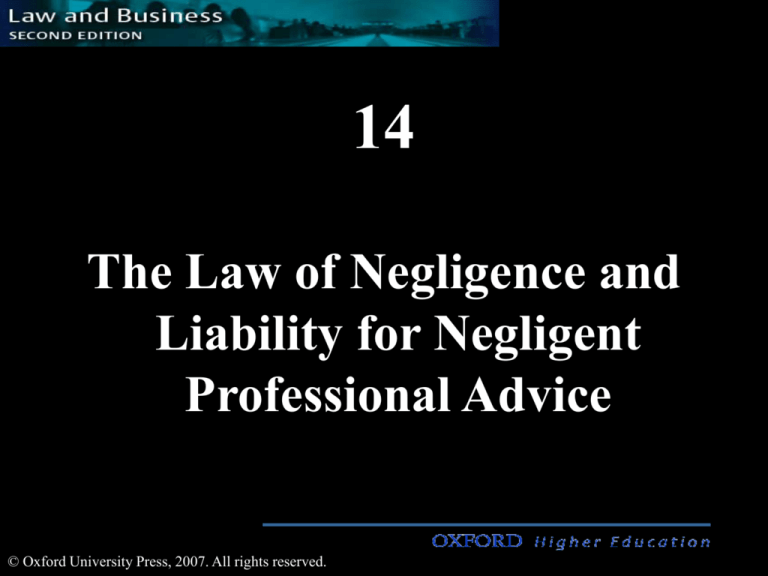
14
The Law of Negligence and
Liability for Negligent
Professional Advice
© Oxford University Press, 2007. All rights reserved.
The Law of Negligence
Objectives - to understand:
• the difference between a breach of contract action and
an action in tort
• the elements required to be proved in an action for
negligence
• liability for negligent mis-statement at common law
• the need for statutory intervention
• liability for negligent professional advice under the
TPA and FTAs (misleading or deceptive conduct).
The Law of Negligence cont ...
What is a tort?
•
a civil wrong (as opposed to a criminal wrong), other than a
breach of contract, which the law will redress by an award of
damages
• distinguish between an action for breach of contract and an
action in tort for negligence
Also note underlying policies:
• criminal law: punishes the offender
• tort liability: primarily compensates person injured.
The Law of Negligence cont ...
Elements: traditional order of analysis The injured party (plaintiff) must prove that:
(i) the defendant owed them a duty of care –
Donaghue v Stevenson, per Lord Atkin (‘snail in the
bottle’ case)
(ii) the defendant breached required standard of care –
ie. negligence, and
(iii) the breach caused the damage which was not too
remote.
The Law of Negligence cont ...
Defences:
• voluntary assumption of risk (consent to risk) by
plaintiff - if so, defendant not liable
• contributory negligence by plaintiff – ie. conduct
by injured party which prevents their right to full
recovery for loss suffered - if so, damages are
apportioned.
The Tort of Negligence
Law of Negligence cont ...
Liability for negligent mis-statement at common law:
• traditional reluctance to grant remedy for negligent
advice leading to financial loss
• concern not to ‘open the floodgates of litigation’
• but see Hedley Byrne & Co Ltd v Heller & Partners
Ltd (House of Lords): cause of action depends on the existence of a ‘special
relationship’ between the parties
• this concept an extension of neighbour principle of
Donaghue v Stevenson.
Law of Negligence cont ...
Negligent mis-statement at common law (cont):
• note test in Shaddock & Associates Pty Ltd v
Paramatta City Council where High Court
broadened scope of duty of care: special relationship can exist even where advisor
does not profess to possess any actual skill or
judgment.
Law of Negligence cont ...
Negligent mis-statement at common law (cont):
• test requires:
(i) advice upon a serious matter and
(ii) circumstances justifying reasonable reliance
(eg. financial advice, but not when given in social
context).
Law of Negligence cont ...
The need for statutory intervention arose out of difficulties at
common law:
(i) plaintiff must establish three pre-conditions of liability
ie. duty of care; breach of required standard of
care/negligence; and consequential loss or damage
(ii) doubt as to whether professional liability (eg. of auditors)
extends to third parties: - courts in both England and Australia have adopted test
which may make it hard for third parties to successfully
sue auditors:
see Esanda Finance Corporation Ltd v Peat Marwick
Hungerfords (HC).
Law of Negligence cont ...
The need for statutory intervention (cont):
High Court in Esanda Finance established test for duty of care to
a third partyTo be successful, third party (C) must prove:
• communication: defendant auditor (A) knew (or ought
reasonably to have known) that the information or advice
given to B (A’s client) would be communicated to C (or a class
of which C is a member), and
• purpose: would be very likely to lead C to enter into a
transaction of the kind C usually enters into, and
• reliance: it would be very likely that C would enter into such a
transaction in reliance on the information or advice from A and
thereby risk suffering economic loss.
Law of Negligence cont ...
Liability for professional advice under TPA and FTAs provisions that widen and extend liability beyond that
which exists at common law
Section 52 TPA:
• liability extends to natural persons (s 6), including
providers of professional services
• liability is strict – s 52 does not require negligence or a
relationship of proximity
• third part liability is open-ended
Law of Negligence cont ...
Liability for professional advice under TPA and FTAs
(cont):
• note what constitutes misleading or deceptive conduct: any
means, active or passive, whereby a false impression is created
• representations concerning future matters: effect of s 51A –
such representations are deemed to be misleading, unless they
can be supported on reasonable grounds
• exclusion clauses: ineffective to limit application of s 52
• wide range of remedies (only civil, no criminal sanctions).
Law of Negligence cont ...
Manufacturers’ liability for defective goods:
• see Part VA TPA - strict liability regime to
overcome need to prove elements of negligence
• goods must be defective according to objective
community standards of safety.
Law of Negligence cont ...
Further tort law reform:
• states are introducing statutes to modify common
law of negligence
• objective: to limit liability in certain situations and
damages awards
• these statutory overlays presuppose knowledge of
common law.







